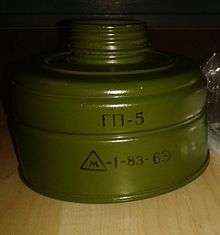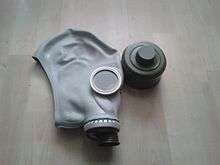GP-5 gas mask
The GP-5 gas mask (Russian: Гражда́нский Противога́з-5, tr. Grazhdanskiy Protivogaz-5) is a Soviet-made single-filter gas mask. It was issued to the Soviet population starting in 1962; production ended in 1990. It is a lightweight mask, weighing 1.09 kg (2.42 lbs). It can operate in all weather and withstand temperatures from −40 degrees (Celsius and Fahrenheit) to 114 °C (237 °F). The GP-5 also comes with sealed glass eye pieces. They were originally made to protect the wearer from radioactive fallout during the Cold War and were distributed to most fallout shelters. They have been tested in Poland to see if they have NBC protective capabilities. It was concluded that the mask will last in an NBC situation for 24 hours. They are a favorite of gas mask collectors because they are common and have the "old" circular eyepieces like masks used in World War II and the "helmet" type masks. The GP-5 kit consists of SHM-62 face piece, GP-5 filter, bag and anti fogging lenses. the GP-5 kit can be also completed SHM-62u SHMP SHM-66mu face pieces.


There has been some debate as to whether or not the filters are dangerous for containing asbestos. In October 2013, Dixon Information found out that the cotton layer of the filter contains 7.5 percent asbestos. Supposedly, if the masks were made after 1972 they use activated charcoal, however filters dating throughout the 80s have tested positive for asbestos. [2][3]. Some claim that the filter is configured so that the asbestos can't be breathed in, so long as the filter layer isn't damaged. It is not advised to use the filters, as the case is made with a percentage of lead which slowly degrades into the filter, along with many other chemicals used in the manufacturing process. The mask also tightly clings to the skin of the head, and so may be uncomfortable for those with all but the shortest hair.
The GP-5 is widely available on the army surplus market, usually very cheaply ($4 to $20), and as such is often used as part of Halloween or other fancy dress costumes.
A variation of the GP-5 gas mask is the GP-5m, which features a circular piece of metal that contains a thin piece of plastic on the inside, which acts as a voice diaphragm ('voicemitter'), as well as a cut-out design for the ear holes. The military version of the GP-5 uses a near-identical facepiece but with an elongated filter housing, to which is fitted a hose which in turn connects to a tall can-type filter which remains supported in the mask's haversack whilst the mask is worn. The GP-5 and military version were issued respectively to the civilian population and armed forces of the Soviet Union and its Warsaw Pact allies, among which they were given differing designations. The East German Armed Forces designated the military version the SchM41M. Although it is unrelated to the GP5 family of masks, a similar variant of the Russian "helmet-style" design with small eyepieces and a voicemitter for those with specific needs relating to the use of optical equipment (i.e. officers - binoculars) was known as the SchMS.
Accessories
The GP-5 was issued in a basic khaki fabric bag with two straps, designed to be easily slung over the shoulder or hung from the waist. The issued bag also contained a decontamination kit (typically either IPP 1 or IPP 8 model), bandages, a first aid kit, and anti-fogging lenses.[4].
Variants
The low-cost and ease of manufacturing of the GP-5 lead to its adoption by a number of states, both for military and industrial use. In China, the GP-5 was adopted for industrial use as the TF-1, modified with a plastic inhale-exhale piece and larger eyepieces. In East Germany, the GP-5 was imported in large numbers throughout the 1980s, with 1.8 million being imported between 1981 and 1988.[5]
See also
References
- Griffin, Kristen (24 October 2013). "Popular Military Surplus Gas Mask Used for Halloween Contains Deadly Asbestos". Mesothelioma Cancer Alliance. Archived from the original on 21 April 2016.
- "Halloween Costume Posed Asbestos Risk". Mesothelioma.net. 6 November 2013. Retrieved 5 September 2018.
- https://vignette.wikia.nocookie.net/gasmaskandrespirator/images/6/6e/Photo_2017-08-09_10-29-35.jpg/revision/latest?cb=20170809093553
- https://www.mil.by/ru/forces/special/rhbz/459/8335/
- http://www.atemschutzddr.de/025ea998a80d98f09/025ea998a80dc71f8/index.html